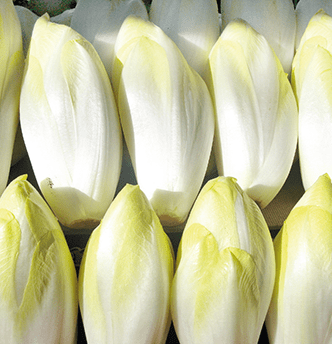Specialising in industrial refrigeration and the food cultivation industry since its creation in 1997, FCV works principally to support the endive production market (80%), but also works with potato and fruit producers in northern France. In addition, FCV is recognised in the market for its vacuum cooling cells. Pascal Hollocou trained as an engineer and was a director at Alcatel Lucent before he launched his new venture by purchasing FCV in 2010, with the aim of being his own boss and exploring a new profession: refrigeration. The company is now a successful operation, with 9 employees and a turnover of 1.85 million euros.
The cultivation of endives (also known as chicory or chicon) is a labour-intensive process. The endive does not exist in a natural state. It is the result of a forcing process developed around the middle of the 19th century. To produce the white leaves, the plants need to be grown in total darkness. Endive production takes place in 5 stages (see below) and requires specific expertise from both the producer and the refrigeration specialist.
Désir Nature SARL has opted for an ecological process
Henri Trévaux, an affiliate member of the Lefebvre family operation based in Peronne, branched out into organic cultivation five years ago. The time was right for such a change and the endive producer also now has the facility to source organically grown root crops locally. In 2014, the production of “Désir nature” organic endives required the construction of a new endive cultivation facility to meet the organic farming criteria for AB accreditation. Henri Trévaux collaborated with FCV to design the industrial refrigeration processes required for endive cultivation. “Refrigeration is crucial, particularly for conserving endives in cold rooms and growing them in forcing rooms”, Pascal Hollocou reminds us.
Industrial process specifications
Once they have been harvested from the fields, the endives need to be stored on pallets in cold rooms, in order to preserve their roots. The aim is to cool the heart of the endives to around 0°C as quickly as possible from the moment they are introduced, and to ensure air circulation between each pallet to avoid them drying out. Then, as required, the endives are removed and placed in the development room.
The endive grows to maturity over three weeks – this is the forcing process. The ambient temperature needs to be between 12°C and 22°C, depending on the stage of development. The room also needs an irrigation system for the forcing trays, allowing water to reach each stack of crates at a temperature of between 8°C and 18°C. It should also be noted that this living product gives off heat.
FCV choose Greenway® Neo
FCV’s process is to guide their customers, where possible, towards a glycolated water system, in order to minimise the quantity of refrigerant in the installation, in line with evolving regulations. Pascal Hollocou discovered Greenway®Neo at technical meetings organised by Climalife in northern France, and offered his customer this vegetable based secondary refrigerant, manufactured from 1-3 propanediol rather than traditional fluids derived from petroleum, to remain faithful to his ecological process.
The decision was taken immediately, Henri Trévaux points out. Although it wasn’t stipulated in the “Agriculture Biologique” label specifications, in terms of organic image, it was important.
Proven experience for a complex and consistent installation
To meet the specifications and remain within the budget, FCV used its accumulated experience in the field to install all of the refrigeration, ventilation and irrigation equipment.
FCV equipped the cold room with an MTA Aries Tech chilled water system with a cooling capacity of 116 kW. Recycled heat from this externally located group is used to produce hot water to defrost the double-flux Profroid Duo 60 evaporators.
For the forcing room, FCV was required to heat and cool water and air. Another MTA chilled water system with a cooling capacity of 93 kW was installed. For the heat, an MTA Hocean geothermal heat pump drawing on groundwater with a heating capacity of 86 kW was installed.
This heat pump heats a facility with a surface area of 25,000 m². The volume of Greenway®Neo secondary refrigerant used is 1,600 Litres for all the circuits. Each item of equipment, where possible, is fitted with frequency converters in order to optimise the installation’s energy efficiency. Frequency converters are rarely used in the agricultural industry, the refrigeration technician reminds us. This is an innovation that allows us to reduce operating costs, which are crucial in endive production facilities such as these.
Endive cultivation, a specialised technology
In order to retain its whiteness, the endive needs to be grown in the dark, in a warm and humid atmosphere. The 5 stages of endive production are:
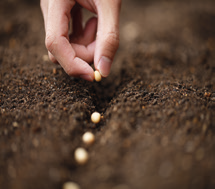 |
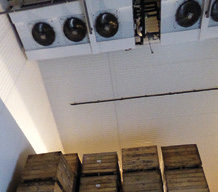 |
 |
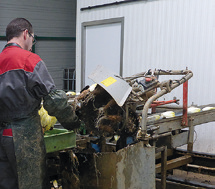 |
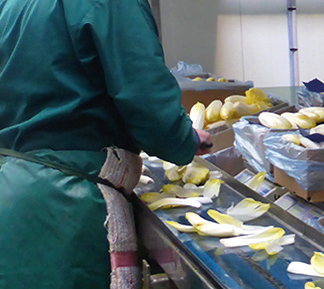 |
| 1. Seeding
To begin with, the seeds are sown in the fields in May. After 5 or 6 months, the endive roots develop in the ground, filling themselves with nutritious elements. They are then uprooted and harvested in November. |
2. Conservation of endive roots
In order to spread production over time, roots are placed into large wooden crates then kept in a cold room for a period of between 8 days and 8 months. |
3. Growing the endives
For the root to produce the endive, it is placed in damp, dark and warm conditions, in a facility known as the forcing room. The roots release their nutrients, allowing the endive to grow over a period of 21 days. |
4. Breaking Once the endive reaches maturity, it is separated from the root (broken). |
5. Peeling
The endives are peeled, sorted and packaged in sachets or cardboard boxes. |

